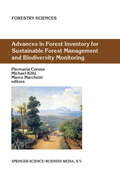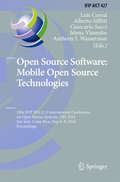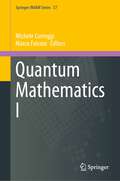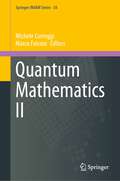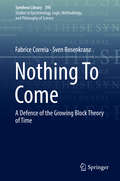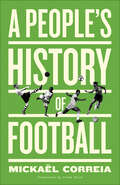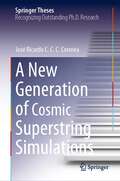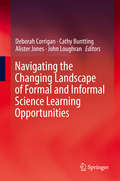- Table View
- List View
Advances in Forest Inventory for Sustainable Forest Management and Biodiversity Monitoring (Forestry Sciences #76)
by Piermaria Corona Michael Köhl Marco MarchettiForests represent a remnant wilderness of high recreational value in the densely populated industrial societies, a threatened natural resource in some regions of the world and a renewable reservoir of essential raw materials for the wood processing industry. In June 1992 the United Nations Conference on the Environment and Development (UNCED) in Rio de Janeiro initiated a world-wide process of negotiation with the aim of ensuring sustainable management, conservation and development of forest resources. Although there seems to be unanimous support for sustainable development from all quarters, there is no generally accepted set of indicators which allows comparisons to be made between a given situation and a desirable one. In a recent summary paper prepared by the FAO Forestry and Planning Division, Ljungman et al. (1999) find that forest resources continue to diminish, while being called upon to produce a greater range of goods and services and that calls for sustainable forest management will simply go unheeded if the legal, policy and administrative environment do not effectively control undesirable practices. Does the concept of sustainable forest management represent not much more than a magic formula for achieving consensus, a vague idea which makes it difficult to match action to rhetoric? The concept of sustainable forest management is likely to remain an imprecise one, but we can contribute to avoiding management practices that are clearly unsustainable.
Molecular Magnetism: From Molecular Assemblies to the Devices (NATO Science Series E: #321)
by E. Coronado Pierre Delhaès D. Gatteschi Joel S. MillerMolecular Magnetism: From Molecular Assemblies to the Devices reviews the state of the art in the area. It is organized in two parts, the first of which introduces the basic concepts, theories and physical techniques required for the investigation of the magnetic molecular materials, comparing them with those used in the study of classical magnetic materials. Here the reader will find: (i) a detailed discussion of the electronic processes involved in the magnetic interaction mechanisms of molecular systems, including electron delocalization and spin polarization effects; (ii) a presentation of the available theoretical models based on spin and Hubbard Hamiltonians; and (iii) a description of the specific physical investigative techniques used to characterize the materials. The second part presents the different classes of existing magnetic molecular materials, focusing on the possible synthetic strategies developed to date to assemble the molecular building blocks ranging from purely organic to inorganic materials, as well as on their physical properties and potential applications. These materials comprise inorganic and organic ferro- and ferrimagnets, high nuclearity organic molecules and magnetic and metallic clusters, spin crossover systems, charge transfer salts (including fulleride salts and organic conductors and superconductors), and organized soft media (magnetic liquid crystals and Langmuir-Blodgett films).
Polyoxometalate Molecular Science (NATO Science Series II: Mathematics, Physics and Chemistry #98)
by E. Coronado Achim Müller M. T. Pope Juan J. Borrás-AlmenarPolyoxometalates (POMs) form a large, distinctive class of molecular inorganic compounds of unrivaled electronic versatility and structural variation, with impacts ranging from chemistry, catalysis, and materials science to biology, and medicine. This book covers the basic principles governing the structure, bonding and reactivity of these metal-oxygen cluster anions and the major developments in their molecular science. The book comprises three sections. The first covers areas ranging from topological principles via synthesis and stability to reactivity in solution. It also focuses on the physical methods currently used to extract information on the molecular and electronic structures as well as the physical properties of these clusters. The second part reviews different types of POMs, focusing on those systems that currently impact other areas of interest, such as supramolecular chemistry, nanochemistry and molecular magnetism. The third section is devoted to POM-based materials and their applications and prospects in catalysis and materials science.
ROS Signaling in Plants: Methods and Protocols (Methods in Molecular Biology #2798)
by Francisco J. Corpas José M. PalmaThis detailed volume presents methodologies for studying reactive oxygen species (ROS) metabolism in plant cells, including techniques for detecting different types of ROS such as superoxide radicals, hydrogen peroxide or singlet oxygen, as well as ROS generating systems such as xanthine oxidoreductase. The book provides alternatives to determine malondialdehyde, electrochemical detection approaches for determining total antioxidant capacity (TAC) as well as enzymatic antioxidants, as well as methods for studying non-enzymatic antioxidants and some components of the secondary metabolism. Written for the highly successful Methods in Molecular Biology series, the chapters in this book provide the kind of detailed implementation advice that leads to ideal results in the laboratory. Authoritative and practical, ROS Signaling in Plants: Methods and Protocols serves as an ideal guide for scientists interested in the metabolism of ROS in plant cells.
The Immune Response to Implanted Materials and Devices: The Impact of the Immune System on the Success of an Implant
by Bruna CorradettiThis book provides a comprehensive overview of the cascade of events activated in the body following the implant of biomaterials and devices. It is one of the first books to shed light on the role of the host immune response on therapeutic efficacy, and reviews the state-of-the-art for both basic science and medical applications. The text examines advantages and disadvantages of the use of synthetic versus natural biomaterials. Particular emphasis is placed on the role of biomimicry in the development of smart strategies able to modulate infiltrating immune cells, thus reducing side effects (such as acute and chronic inflammation, fibrosis and/or implant rejection) and improving the therapeutic outcome (healing, tissue restoration). Current cutting-edge approaches in tissue engineering, regenerative medicine, and nanomedicine offer the latest insights into the role immunomodulation in improving tolerance during tissue transplant in the treatment of orthopaedic, pancreatic, and hepatic diseases. "Immune Response to Implanted Materials and Devices" is intended for an audience of graduate students and professional researchers in both academia and industry interested in the development of smart strategies, which are able to exploit the self-healing properties of the body and achieve functional tissue restoration.
Extended Abstracts Spring 2013: Complex Systems; Control of Infectious Diseases (Trends in Mathematics #2)
by Álvaro Corral Anna Deluca Francesc Font-Clos Pilar Guerrero Andrei Korobeinikov Francesco MassucciThe two parts of this volume feature seventeen and six extended conference abstracts corresponding to selected talks given by participants at "Joint CRM-Imperial College Workshop in Complex Systems" and "Emergence, Spread and Control of Infectious Diseases" respectively, both held at the Centre de Recerca Matemàtica in Barcelona in spring 2013. Most of them are short articles giving preliminary presentations of new results not yet published in regular research journals. The articles are the result from a direct collaboration among active researchers in the area after working in a dynamic and productive atmosphere. Almost everything that is interesting and important for society is complex; here, examples scattered across science are presented in order to illustrate the cross-disciplinary richness of state-of-the-art complex systems research: fracture avalanches and rain showers that mimic earthquakes; highly organized graphs that account for processes in neural networks, metabolic networks, food webs, or language; models for DNA dynamics; or statistical methods to test complexity in the form of structure along many different scales. The mathematics is put to work for the modeling of the real system, and the models are kept at a minimum level to allow the understanding of the essentials of the real system. The book is intended for established researchers, as well as for PhD and postdoc students who wish to learn more about the latest advances in these active areas of research.
Open Source Software: 10th IFIP WG 2.13 International Conference on Open Source Systems, OSS 2014, San José, Costa Rica, May 6-9, 2014, Proceedings (IFIP Advances in Information and Communication Technology #427)
by Luis Corral Alberto Sillitti Giancarlo Succi Jelena Vlasenko Anthony I. WassermanThis book constitutes the refereed proceedings of the 10th International IFIP WG 2.13 Conference on Open Source Systems, OSS 2014, held in San José, Costa Rica, in May 2014. The 16 revised full papers and 16 short papers presented together with 5 poster papers were carefully reviewed and selected from 61 submissions. They have been organized in the following topical sections: open source visualization and reporting; open source in business modeling; open source in mobile and web technologies; open source in education and research; development processes of open source products; testing and assurance of open source projects; and global impact on open source communities and development. The last section consists of five case studies and demonstrations of open source projects.
Innovation in Physical Activity and Sport: Selected Papers from the 1st International Virtual Conference on Technology in Physical Activity and Sport (Lecture Notes in Bioengineering)
by Borja Sañudo Corrales Jerónimo García-FernándezThis book reports on cutting-edge digital technologies and their applications in physical activity and sport. Gathering selected chapters from the 1st International Conference on Technology in Physical Activity and Sport, held virtually on November 24-27, 2020, from Seville, Spain, it offers a practice-oriented and evidence-based perspective on how technologies can be used for evaluation and control of different parameter relating to sport, physical activity, and health. It covers how digital technologies can be applied for training and monitoring purposes, and for improving athlete’s performance, how they influence sport habits in different populations, demonstrating their growing influence in sport businesses (such as fitness centers) and management, and provides new findings on the connection between physical activity and human health, suggesting some interesting directions for future studies. With a good balance of laboratory research and information relevant for professional trainers, this book will provide bioengineers, sport scientists, and physiotherapists with timely information and a multidisciplinary perspective on the use of digital technologies to improve fitness, wellbeing and health in different population groups.
Clinical Proteomics: Methods and Protocols (Methods in Molecular Biology #2420)
by Fernando J. Corrales Alberto Paradela Miguel MarcillaThis detailed volume explores techniques in clinical proteomics, an emerging discipline aimed at deciphering the molecular mechanisms underlying the progression of diseases and at identifying new biomarkers and therapeutic targets to expand the physicians’ toolbox for precision medicine-based patient care. From sample processing to multi-omics approaches, the book provides straight-forward protocols on a wide array of vital areas of study. Written for the highly successful Methods in Molecular Biology series, chapters include introductions to their respective topics, lists of the necessary materials and reagents, step-by-step, readily reproducible protocols, and tips on troubleshooting and avoiding known pitfalls. Authoritative and practical, Clinical Proteomics: Methods and Protocols serves as an ideal guide for researchers working to expand upon the knowledge base needed to push forward toward a more personalized version of medicine.
The Innovation Game: A New Approach to Innovation Management and R&D
by Armelle Corre Gerald MischkeProvides first time integrated approach to R and D-project, -pipeline and -department management from a micro-, meso- and macroscopic view. Derives 21 easy and ready to apply rules for a better design and a superior control of R and D without losinf sight of high scientific standards.
Ni- and Fe-Based Cross-Coupling Reactions (Topics in Current Chemistry Collections)
by Arkaitz CorreaThe series Topics in Current Chemistry Collections presents critical reviews from the journal Topics in Current Chemistry organized in topical volumes. The scope of coverage is all areas of chemical science including the interfaces with related disciplines such as biology, medicine and materials science. The goal of each thematic volume is to give the non-specialist reader, whether in academia or industry, a comprehensive insight into an area where new research is emerging which is of interest to a larger scientific audience. Each review within the volume critically surveys one aspect of that topic and places it within the context of the volume as a whole. The most significant developments of the last 5 to 10 years are presented using selected examples to illustrate the principles discussed. The coverage is not intended to be an exhaustive summary of the field or include large quantities of data, but should rather be conceptual, concentrating on the methodological thinking that will allow the non-specialist reader to understand the information presented. Contributions also offer an outlook on potential future developments in the field.
Environmental and Financial Performance Evaluation in 3D Printing Using MFCA and LCA (SpringerBriefs in Applied Sciences and Technology)
by Marcell Mariano Corrêa Maceno Tiago Yuiti Kamiya Mariana KleinaThis book presents the methodology of environmental and financial performance evaluation in 3D printing processes using the MFCA and LCA. This methodology is divided into 7 main steps, which are: a) identification of the analysis problem (for example, comparison of different types of 3D printer for use in a given purpose, comparison of different printing materials for the same 3D printer technology, among others) and definition of printing parameters; b) definition of the product to be printed; c) preparation of the printing process flow diagram; d) definition or measurement of the lifespan of the printed product; e) data collection for the implementation of the LCA tool (for example, mass and energy balances); f) data collection for the implementation of the MFCA tool (for example, mass balances, energy balances, mass costs, energy costs, labor costs, etc.); and g) comparative assessment of the financial and environmental performance of 3D printing. As a way of exemplifying the application of this methodology, a real case is presented involving the comparison of two types of materials (Polylactic Acid – PLA – and Polyethylene Glycol Polyterephthalate – PETG) used in the 3D printing process by FDM technology. The part printed in this real case was a clearance gauge used as a joint spacing control by an automobile industry located in Brazil. The development of the methodology and consequent application has shown that it can be used by users of 3D printing, in the most diverse areas, to support their decision in choices that can present the best performance, both financial and environmental.
Coastal Ocean Observing: Platforms, Sensors and Systems
by Jorge E. CorredorThis manual describes the wide range of electromechanical, electrochemical and electro-optical transducers at the heart of current field-deployable ocean observing instruments. Their modes of operation, precision and accuracy are discussed in detail. Observing platforms ranging from the traditional to the most recently developed are described, as are the challenges of integrating instrument suits to individual platforms. Technical approaches are discussed to address environmental constraints on instrument and platform operation such as power sources, corrosion, biofouling and mechanical abrasion. Particular attention is also given to data generated by the networks of observing platforms that are typically integrated into value-added data visualization products, including numerical simulations or models. Readers will learn about acceptable data formats and representative model products. The last section of the book is devoted to the challenges of planning, deploying and maintaining coastal ocean observing systems. Readers will discover practical applications of ocean observations in diverse fields including natural resource conservation, commerce and recreation, safety and security, and climate change resiliency and adaptation. This volume will appeal to ocean engineers, oceanographers, commercial and recreational ocean data users, observing systems operators, and advanced undergraduate and graduate students in the field of ocean observing.
Quantum Mathematics I (Springer INdAM Series #57)
by Michele Correggi Marco FalconiThis book is the first volume that provides an unique overview of the most recent and relevant contributions in the field of mathematical physics with a focus on the mathematical features of quantum mechanics. It is a collection of review papers together with brand new works related to the activities of the INdAM Intensive Period "INdAM Quantum Meetings (IQM22)", which took place at the Politecnico di Milano in Spring 2022 at Politecnico di Milano. The range of topics covered by the book is wide, going ranging from many-body quantum mechanics to semiclassical analysis, quantum field theory, Schrödinger and Dirac operators and open quantum systems
Quantum Mathematics II (Springer INdAM Series #58)
by Michele Correggi Marco FalconiThis book is the second volume that provides an unique overview of the most recent and relevant contributions in the field of mathematical physics with a focus on the mathematical features of quantum mechanics. It is a collection of review papers together with brand new works related to the activities of the INdAM Intensive Period "INdAM Quantum Meetings (IQM22)", which took place at the Politecnico di Milano in Spring 2022 at Politecnico di Milano. The range of topics covered by the book is wide, going ranging from many-body quantum mechanics to quantum field theory and open quantum systems.
Nothing To Come: A Defence of the Growing Block Theory of Time (Synthese Library #395)
by Fabrice Correia Sven RosenkranzThis monograph is a detailed study, and systematic defence, of the Growing Block Theory of time (GBT), first conceived by C.D. Broad. The book offers a coherent, logically perspicuous and ideologically lean formulation of GBT, defends it against the most notorious objections to be found in the extant philosophical literature, and shows how it can be derived from a more general theory, consistent with relativistic spacetime, on the pre-relativistic assumption of an absolute and total temporal order.The authors devise axiomatizations of GBT and its competitors which, against the backdrop of a shared quantified tense logic, significantly improves the prospects of their comparative assessment. Importantly, neither of these axiomatizations involves commitment to properties of presentness, pastness or futurity. The authors proceed to address, and defuse, a number of objections that have been marshaled against GBT, including the so-called epistemic objection according to which the theory invites skepticism about our temporal location. The challenge posed by relativistic physics is met head-on, by replacing claims about temporal variation by claims about variation across spacetime.The book aims to achieve the greatest possible rigor. The background logic is set out in detail, as are the principles governing the notions of precedence and temporal location. The authors likewise devise a novel spacetime logic suited for the articulation, and comparative assessment, of relativistic theories of time. The book comes with three technical appendices which include soundness and completeness proofs for the systems corresponding to GBT and its competitors, in both their pre-relativistic and relativistic forms. The book is primarily directed at researchers and graduate students working on the philosophy of time or temporal logic, but is of interest to metaphysicians and philosophical logicians more generally.
A People's History of Football (People's History)
by Mickaël Correia‘A fascinating journey through the game’s history [as] a vehicle of change’ Shaka Hislop, former footballer, anti-racist educator and broadcaster‘Correia takes us around the world to examine how football has produced the kind of political energy that can change minds and even topple governments’ Dave Zirin, Sports Editor, The Nation‘An essential history of [the] fans, players and teams that built the game and harnessed it as a force for good’ Flo Lloyd-Hughes, sportswriter and broadcaster‘An essential read for football fans everywhere’ Juliet Jacques, writer, filmmaker and journalistFootball is so much more than the billionaire owners and eye-watering signing fees that dominate the headlines. Look beyond the Premiership and the World Cup, the sublime brilliance of Messi and Mbappé, and you’ll find a story unparalleled in the world of sport.From England, France and Germany to Palestine, South Africa and Brazil, A People’s History of Football reveals how the ‘beautiful game’ has been a powerful instrument of emancipation for workers, feminists, anti-colonialist activists, young people and protesters around the world.Countering the clichés about football fans, Mickaël Correia dives into football countercultures born after the Second World War, from English hooligans to the ultras who played a central role in the ‘Arab Spring’. And with chapters on anti-fascism, the women’s game, and the rise in community-owned clubs, Correia reminds us that football can be a powerful social and political force – as generous as it is subversive.Mickaël Correia is a journalist at Mediapart. He is the author of several books. He has written for Le Monde Diplomatique, Le Canard Enchaîné and La Revue du Crieur. His passion for football began when he was 4, with kickabouts on the streets of Roubaix.
A New Generation of Cosmic Superstring Simulations (Springer Theses)
by José Ricardo CorreiraTopological defects are an expected consequence of phase transitions in the early Universe. As such these objects, if detected, provide unequivocal evidence of physics beyond the Standard Model. This means they are prime targets for new observational facilities. However, our understanding of defects is heavily bottlenecked by computational limitations. In this book, the author explores the use of accelerator hardware to alleviate this problem, presenting the world’s first (multiple-)GPU defect simulations. Such simulations can evolve a network of line-like cosmic strings at an unprecedented resolution. Then these are used to obtain the most accurate to date calibrations of semi-analytical modelling and to show the impact of accuracy on observational consequences of strings. Lastly, a modified version of this application is used to study interconnected networks of strings in greater detail than ever before. This book benefits any student or researcher who wishes to learn about field theory simulations in the early Universe and about supercomputing with multiple accelerators.
Gesammelte Abhandlungen zur Vererbungswissenschaft aus periodischen Schriften 1899-1924. Zum 60. Geburtstag von C. E. Correns hrsg. von der Deutschen Gesellschaft für Vererbungswissenschaft.
by Carl CorrensDieser Buchtitel ist Teil des Digitalisierungsprojekts Springer Book Archives mit Publikationen, die seit den Anfängen des Verlags von 1842 erschienen sind. Der Verlag stellt mit diesem Archiv Quellen für die historische wie auch die disziplingeschichtliche Forschung zur Verfügung, die jeweils im historischen Kontext betrachtet werden müssen. Dieser Titel erschien in der Zeit vor 1945 und wird daher in seiner zeittypischen politisch-ideologischen Ausrichtung vom Verlag nicht beworben.
The Future in Learning Science: What's In It For The Learner?
by Deborah Corrigan Cathy Buntting Justin Dillon Alister Jones Richard GunstoneThis volume considers the future of science learning - what is being learned and how it is being learned - in formal and informal contexts for science education. To do this, the book explores major contemporary shifts in the forms of science that could or should be learned in the next 20 years, what forms of learning of that science should occur, and how that learning happens, including from the perspective of learners. In particular, this volume addresses shifts in the forms of science that are researched and taught post-school – emerging sciences, new sciences that are new integrations, “futures science”, and increases in the complexity and multidisciplinarity of science, including a multidisciplinarity that embraces ways of knowing beyond science. A central aspect of this in terms of the future of learning science is the urgent need to engage students, including their non-cognitive, affective dimensions, both for an educated citizenry and for a productive response to the ubiquitous concerns about future demand for science-based professionals. Another central issue is the actual impact of ICT on science learning and teaching, including shifts in how students use mobile technology to learn science.
Values in Science Education: The Shifting Sands
by Deborah Corrigan Cathy Buntting Angela Fitzgerald Alister JonesIn 2007, the Monash-Kings College London International Centre for the Study of Science and Mathematics Curriculum edited a book called The Re-emergence of Values in Science Education. This book reflects on how values have been considered since this original publication, particularly in terms of socio-cultural, economic and political factors that have impacted broadly on science, technology and society, and more specifically on informal and formal science curricula. Hence, the title of this book has been framed as Values in Science Education: The shifting sands. As in the first book, this collection focuses on values that are centrally associated with science and its teaching, and not the more general notion of values such as cooperation or teamwork that are also important values in current curricula. Such values have indeed become more of a focus in science education. This may be a response to the changing global context, where technological changes have been rapid and accelerating. In such complex and risky environments, it is our guiding principles that become the important mainstays of our decisions and practices. In terms of science education, what is becoming clearer is that traditional content and traditional science and scientific methods are not enough for science and hence science education to meet such challenges. While shifts in values in science education continue, tensions remain in curriculum development and implementation, as evidenced by the continued diversity of views about what and whose values matter most.
Navigating the Changing Landscape of Formal and Informal Science Learning Opportunities
by Deborah Corrigan Cathy Buntting Alister Jones John LoughranThis book presents research involving learning opportunities that are afforded to learners of science when the focus is on linking the formal and informal science education sectors. It uses the metaphor of a "landscape" as it emphasises how the authors see the possible movement within a landscape that is inclusive of formal, informal and free-choice opportunities. The book explores opportunities to change formal school science education via perspectives and achievements from the informal and free-choice science education sector within the wider lifelong, life-wide education landscape. Additionally it explores how science learning that occurs in a more inclusive landscape can demonstrate the potential power of these opportunities to address issues of relevance and engagement that currently plague the learning of science in school settings. Combining specific contexts, case studies and more general examples, the book examines the science learning landscapes by means of the lens of an ecosystem and the case of the Synergies longitudinal research project. It explores the relationships between school and museum, and relates the lessons learned through encounters with a narwhal. It discusses science communication, school-community partnerships, socioscientific issues, outreach education, digital platforms and the notion of a learning ecology.
Essential Forensic Pathology: Core Studies and Exercises
by Gilbert CorriganA myriad of different scenarios await those entering the field of forensic pathology, ranging from gunshot wounds to asphyxiation to explosives to death from addiction. Essential Forensic Pathology: Core Studies and Exercises helps prepare pathologists in training by establishing what they must know about the most common death scenes they will enco
Essential Forensic Pathology: Core Studies and Exercises
by Gilbert CorriganA myriad of different scenarios await those entering the field of forensic pathology, ranging from gunshot wounds to asphyxiation to explosives to death from addiction. Essential Forensic Pathology: Core Studies and Exercises helps prepare pathologists in training by establishing what they must know about the most common death scenes they will enco
